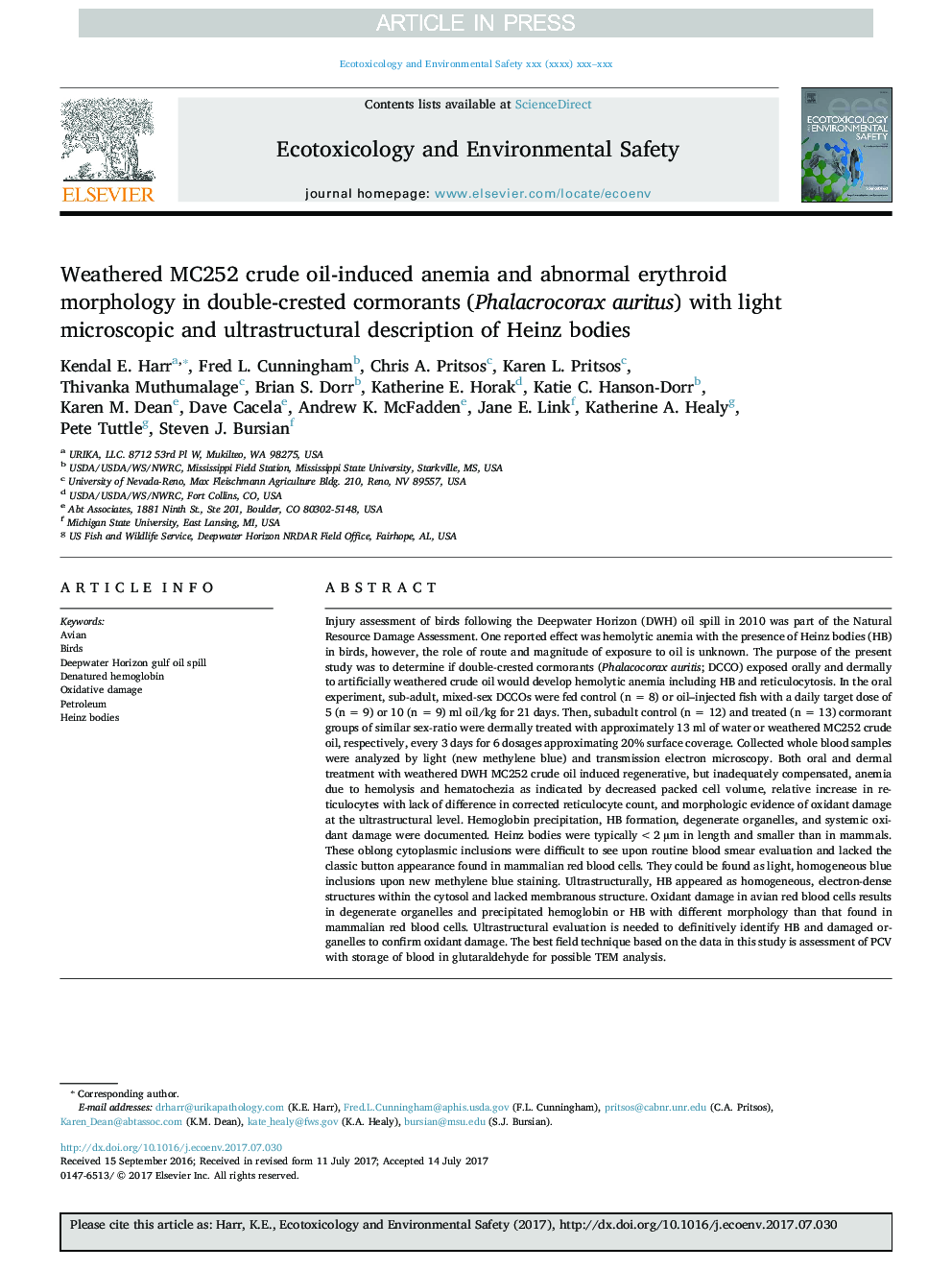| کد مقاله | کد نشریه | سال انتشار | مقاله انگلیسی | نسخه تمام متن |
|---|---|---|---|---|
| 8854863 | 1618918 | 2017 | 11 صفحه PDF | دانلود رایگان |
عنوان انگلیسی مقاله ISI
Weathered MC252 crude oil-induced anemia and abnormal erythroid morphology in double-crested cormorants (Phalacrocorax auritus) with light microscopic and ultrastructural description of Heinz bodies
دانلود مقاله + سفارش ترجمه
دانلود مقاله ISI انگلیسی
رایگان برای ایرانیان
کلمات کلیدی
موضوعات مرتبط
علوم زیستی و بیوفناوری
علوم محیط زیست
شیمی زیست محیطی
پیش نمایش صفحه اول مقاله

چکیده انگلیسی
Injury assessment of birds following the Deepwater Horizon (DWH) oil spill in 2010 was part of the Natural Resource Damage Assessment. One reported effect was hemolytic anemia with the presence of Heinz bodies (HB) in birds, however, the role of route and magnitude of exposure to oil is unknown. The purpose of the present study was to determine if double-crested cormorants (Phalacocorax auritis; DCCO) exposed orally and dermally to artificially weathered crude oil would develop hemolytic anemia including HB and reticulocytosis. In the oral experiment, sub-adult, mixed-sex DCCOs were fed control (n = 8) or oil-injected fish with a daily target dose of 5 (n = 9) or 10 (n = 9) ml oil/kg for 21 days. Then, subadult control (n = 12) and treated (n = 13) cormorant groups of similar sex-ratio were dermally treated with approximately 13 ml of water or weathered MC252 crude oil, respectively, every 3 days for 6 dosages approximating 20% surface coverage. Collected whole blood samples were analyzed by light (new methylene blue) and transmission electron microscopy. Both oral and dermal treatment with weathered DWH MC252 crude oil induced regenerative, but inadequately compensated, anemia due to hemolysis and hematochezia as indicated by decreased packed cell volume, relative increase in reticulocytes with lack of difference in corrected reticulocyte count, and morphologic evidence of oxidant damage at the ultrastructural level. Hemoglobin precipitation, HB formation, degenerate organelles, and systemic oxidant damage were documented. Heinz bodies were typically <2 µm in length and smaller than in mammals. These oblong cytoplasmic inclusions were difficult to see upon routine blood smear evaluation and lacked the classic button appearance found in mammalian red blood cells. They could be found as light, homogeneous blue inclusions upon new methylene blue staining. Ultrastructurally, HB appeared as homogeneous, electron-dense structures within the cytosol and lacked membranous structure. Oxidant damage in avian red blood cells results in degenerate organelles and precipitated hemoglobin or HB with different morphology than that found in mammalian red blood cells. Ultrastructural evaluation is needed to definitively identify HB and damaged organelles to confirm oxidant damage. The best field technique based on the data in this study is assessment of PCV with storage of blood in glutaraldehyde for possible TEM analysis.
ناشر
Database: Elsevier - ScienceDirect (ساینس دایرکت)
Journal: Ecotoxicology and Environmental Safety - Volume 146, December 2017, Pages 29-39
Journal: Ecotoxicology and Environmental Safety - Volume 146, December 2017, Pages 29-39
نویسندگان
Kendal E. Harr, Fred L. Cunningham, Chris A. Pritsos, Karen L. Pritsos, Thivanka Muthumalage, Brian S. Dorr, Katherine E. Horak, Katie C. Hanson-Dorr, Karen M. Dean, Dave Cacela, Andrew K. McFadden, Jane E. Link, Katherine A. Healy, Pete Tuttle,